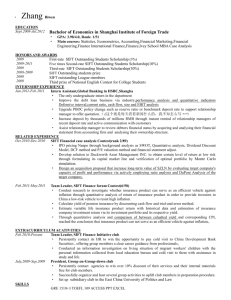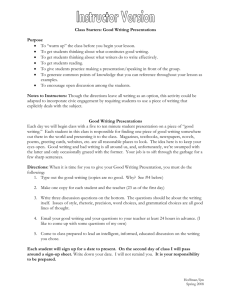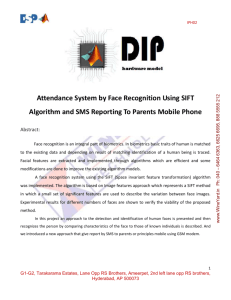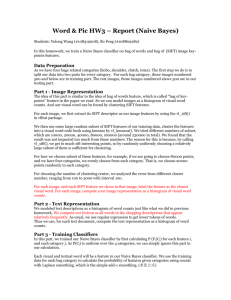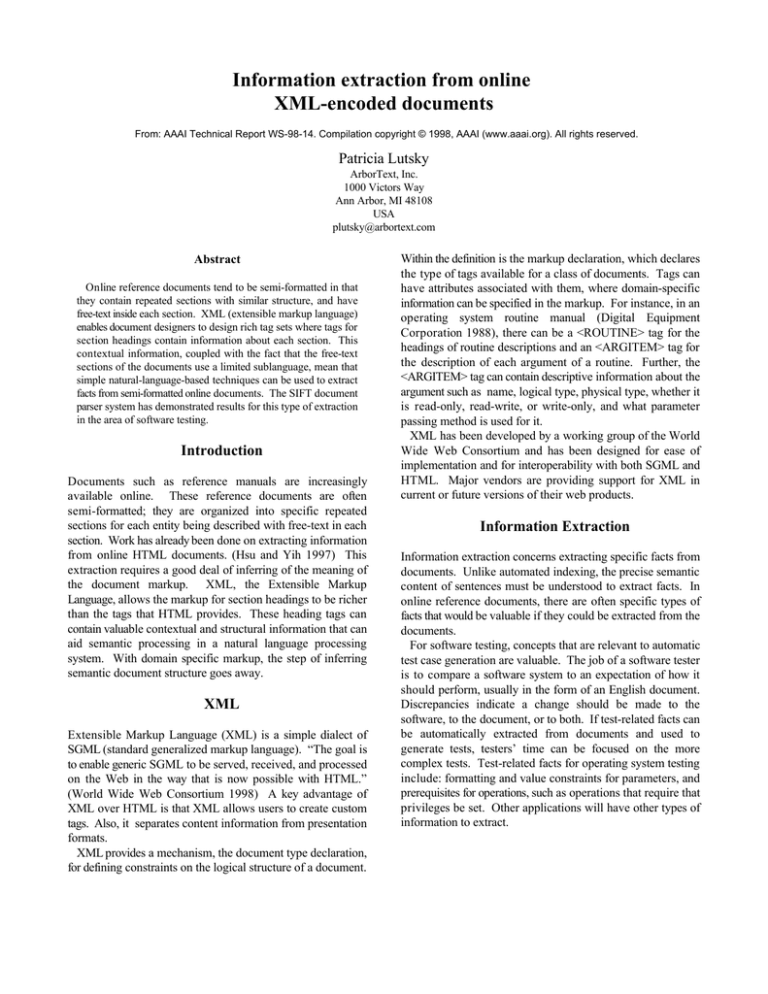
Information extraction from online
XML-encoded documents
From: AAAI Technical Report WS-98-14. Compilation copyright © 1998, AAAI (www.aaai.org). All rights reserved.
Patricia Lutsky
ArborText, Inc.
1000 Victors Way
Ann Arbor, MI 48108
USA
plutsky@arbortext.com
Abstract
Online reference documents tend to be semi-formatted in that
they contain repeated sections with similar structure, and have
free-text inside each section. XML (extensible markup language)
enables document designers to design rich tag sets where tags for
section headings contain information about each section. This
contextual information, coupled with the fact that the free-text
sections of the documents use a limited sublanguage, mean that
simple natural-language-based techniques can be used to extract
facts from semi-formatted online documents. The SIFT document
parser system has demonstrated results for this type of extraction
in the area of software testing.
Introduction
Documents such as reference manuals are increasingly
available online. These reference documents are often
semi-formatted; they are organized into specific repeated
sections for each entity being described with free-text in each
section. Work has already been done on extracting information
from online HTML documents. (Hsu and Yih 1997) This
extraction requires a good deal of inferring of the meaning of
the document markup. XML, the Extensible Markup
Language, allows the markup for section headings to be richer
than the tags that HTML provides. These heading tags can
contain valuable contextual and structural information that can
aid semantic processing in a natural language processing
system. With domain specific markup, the step of inferring
semantic document structure goes away.
XML
Extensible Markup Language (XML) is a simple dialect of
SGML (standard generalized markup language). “The goal is
to enable generic SGML to be served, received, and processed
on the Web in the way that is now possible with HTML.”
(World Wide Web Consortium 1998) A key advantage of
XML over HTML is that XML allows users to create custom
tags. Also, it separates content information from presentation
formats.
XML provides a mechanism, the document type declaration,
for defining constraints on the logical structure of a document.
Within the definition is the markup declaration, which declares
the type of tags available for a class of documents. Tags can
have attributes associated with them, where domain-specific
information can be specified in the markup. For instance, in an
operating system routine manual (Digital Equipment
Corporation 1988), there can be a <ROUTINE> tag for the
headings of routine descriptions and an <ARGITEM> tag for
the description of each argument of a routine. Further, the
<ARGITEM> tag can contain descriptive information about the
argument such as name, logical type, physical type, whether it
is read-only, read-write, or write-only, and what parameter
passing method is used for it.
XML has been developed by a working group of the World
Wide Web Consortium and has been designed for ease of
implementation and for interoperability with both SGML and
HTML. Major vendors are providing support for XML in
current or future versions of their web products.
Information Extraction
Information extraction concerns extracting specific facts from
documents. Unlike automated indexing, the precise semantic
content of sentences must be understood to extract facts. In
online reference documents, there are often specific types of
facts that would be valuable if they could be extracted from the
documents.
For software testing, concepts that are relevant to automatic
test case generation are valuable. The job of a software tester
is to compare a software system to an expectation of how it
should perform, usually in the form of an English document.
Discrepancies indicate a change should be made to the
software, to the document, or to both. If test-related facts can
be automatically extracted from documents and used to
generate tests, testers’ time can be focused on the more
complex tests. Test-related facts for operating system testing
include: formatting and value constraints for parameters, and
prerequisites for operations, such as operations that require that
privileges be set. Other applications will have other types of
information to extract.
Parsing Semi-structured Documents
in XML
XML tags allow for domain-specific information in section
headings and this context information is sufficient for
information extraction. As described in Section 2, the
following tags for descriptions of arguments to an OpenVMS
(Digital Equipment Corporation 1988) operating system
routine include the name, logical type (vms-usage), type, access
method, and parameter passing mechanism.
<ARGITEM
name=”pidadr”
vms-usage =”process_id”
type=”longword (unsigned)”
access =”write only”
mechanism =”by reference”/>
<ARGITEM
name =”image”
vms-usage =”logical_name”
type=”character-coded text string”
access=”read only”
mechanism =”by descriptor”/>
This information is used to generate a header in the
document. It is also used to provide contextual information to
a document parser, providing much more information than a
simple <H1> or <H2> HTML tag would.
For example, if the sentence
All undefined bits in the longword must
be 0
occurs in the description of the pidadr argument that is headed
by the above pidadr ARGITEM, the SIFT document parser
would know from the
type=”longword (unsigned)”
information in the ARGITEM tag that the type of the argument
is longword(unsigned). Then, when the parser identifies the
referent of “the longword,” the heading correctly directs the
semantic processing to choose the argument that is being
described.
Another example is the processing of the sentence
SYSPRV is required to specify the
system directory table
Here, the argument structure for the verb “specify” indicates
that it requires a value and the recipient of the value. “the
system directory table” is the value, but there is no explicit
mention of the recipient of the value. It is the OpenVMS
parameter that is being described, partab, and the parser can
ascertain that from the context information that is contained in
the ARGITEM tag. Further, the vms-usage information would
indicate that “the system directory table” is a valid value for the
type of this parameter.
Tags for other section headings may provide valuable
information as well. For example, one OpenVMS data type is
the item list: a list structure where each piece of information is
represented in an item, and different item codes are relevant for
different parameters. If the sentence
This item code may appear anywhere
in the item list.
is contained in a section with headings
<ARGITEM
name = “itmlst”
vms-usage=”item_list_3"
type=”longword (unsigned)”
access=”read only”
mechanism=”by reference”/>
<PARAMITEM
name = “LNM$_TABLE”
type=”item_code”/>
The sentence processing resolves the reference for “this item
code” to be LNM$_TABLE from the name value of the
PARAMITEM tag, and resolves the reference for “the item
list” from the name value of the ARGITEM tag.
To further simplify parsing of online reference manuals, the
text inside the free-text sections uses a restricted sublanguage
(Grishman and Kittredge 1986) (Kittredge and Lehrberger
1982), so simple domain-specific parsing techniques can be
effective. A sublanguage is a semantically constrained version
of a natural language spoken by a particular group of people.
A sublanguage is not a subset of a natural language, but rather
has its own grammar that reflects the way the group of people
communicates. For reference manuals, linguistic constructs
such as puns and fanciful metaphors will not be used. The tone
is simple and uniform. Specific concepts tend to be described
the same way throughout a document. In fact, as I will show,
certain concepts are expressed in a limited number of
identifiable sentence types.
SIFT
SIFT (Lutsky 1998), which stands for "specification
information from text," is a natural-language-based information
extraction tool that can extract test-related information from the
free-text portion of semi-formatted documents. It uses simple
techniques for information extraction from texts, yet has been
able to improve tests for the domains of OpenVMS operating
system testing (Lutsky 1994) and XCON expert system
database testing (Barker and O'Connor 1989) (Schlimmer
1991).
Figure 1 shows the architecture of SIFT. The input to the
system is software documentation; the output is additions to a
test system. These additions will take different forms
depending on the test system. SIFT contains four modules.
These include both domain-independent components (a testing
knowledge module and a general purpose parser) and
domain-dependent components (a sublanguage grammar and a
domain model). The domain-independent modules are robust
enough to work for multiple domains so that a tester wanting to
use the SIFT document parser in a new domain only has to
develop the domain model and sublanguage grammar based on
the specific way that information is expressed in the documents.
Input and Output
The input to SIFT is a semi-formatted online document. SIFT
is most valuable for documents that have a long lifespan, where
the system being described will be continually adding new
features. That way, the grammar can be written once, and then
run repeatedly on the document as it changes with new
versions.
The output of the SIFT document parser is a canonical form
of the relevant information that can be easily translated into the
correct format for additions to the test system. For example, if
allowable limits on an integer parameter are being extracted,
the sentence
The maximum value you can specify
with the BUFQUO argument is 65355.
is translated to a canonical form such as
The maximum value for BUFQUO is
65355.
and an encoded canonical form such as
(maximum_value BUFQUO 65355)
that can be mechanically translated into the format used by the
testing system. The required output format is described as part
of the sublanguage grammar for the domain.
Sentence types
In SIFT, a sentence type is a group of sentences of a
sublanguage that are structurally the same. For example, the
following sentences are of the same type:
The box is on the counter
The pen is on a box
The shoe is under the counter
A sentence type can be identified with a grammar as the
following description of the three example sentences:
NP is PREP NP
Components of the grammar may be domain-specific as in the
following sentence type description:
PRIVILEGE is required to VERB NP
where PRIVILEGE is a noun phrase describing an OpenVMS
operating system privilege. A corresponding sentence is
SYSNAM privilege is required to specify
executive or kernel mode access for a
logical name table.
SIFT modules
The domain-independent general-purpose parser has four
parsing steps, and the sublanguage grammar parts correspond
to them. The four parts of the grammar are:
- preprocessing directives
- phrase structure grammar
- heuristics for identifying sentence types
- heuristics for extracting semantic information.
The grammar only covers the structures of the sentence types
that are used to convey testable information in the target
document. It reflects the sentence type grammar as in
Figure 1. Architecture of SIFT
NP MODAL CONTAIN-VERB no more
than NUMBER characters.
for sentences such as
The string may contain no more than
31 characters.
An equivalence name can contain no
more than 255 characters.
The corresponding parser is based on an ATN (augmented
transition net) (Woods 1970). It looks at each appropriate
section of the document and its contextual information. Within
each section, it works on a sentence-by-sentence basis,
although a "sentence" of the sublanguage may only be a
sentence fragment of English. If it is able to parse a sentence
and derive a semantic representation for it, it returns the
corresponding semantic expression. If not, it simply ignores
the sentence and moves on to the next one.
The phrase structure output is a parse tree. Its format is
domain specific and may contain semantic information as well
as syntactic groupings.
This tree is passed to two types of heuristics: one set of
heuristics identifies the sentence type based on the phrase
structure description of the sentence and the other set of
heuristics converts the semantic contents of the sentence to a
domain-specific useful form.
This second set of heuristics takes advantage of the XMLencoded knowledge in the document for semantic processing.
As shown in Section 4, this knowledge can be used in
reference resolution and in determination of the correct values
for the argument structure of lexical items. It can also help with
missing references in informal documents, such as if the
sentence fragment
Only relevant for software.
occurs in a specification document. The missing sentence
subject is obtained from the heading tag of the section for the
attribute that is being described.
The domain model is based on a linguistic formalism, the
generative lexicon (Pustejovsky 1995). By using a linguistic
formalism, the language-related information is combined with
general semantics of domain model entries.
The other domain-independent module is the testing
knowledge module. It contains general knowledge about
testing and common test case scenarios. Currently it is used
only when translating canonical sentences into the correct
format for additions to the test system. In the future its role
might be expanded to assist further in SIFT’s processing of the
document.
Results
The SIFT system has been measured by comparing the test
information that it can extract from the reference pages of the
OpenVMS System Services Reference Manual (Digital
Equipment Corporation 1988) to a gold standard set of tests
that were written by a human tester. (This document was
actually written using SGML, but it could have been encoded
in XML.) The tests, with a total of 174 test cases, are for the
subset of the OpenVMS operating system that concerns logical
name translation. SIFT can extract information that accounts
for 25 test cases, or 14% of the gold standard. Fourteen percent
is quite good for automatic test generation. It represents a
significant time saving for testers and would allow testers to
concentrate on the harder tests.
SIFT can extract facts about argument restrictions, such as
This attribute may be specified only for
process-private logical name tables.
LNM$_CHAIN must be the last item
code in the current item list.
It can also extract facts about required arguments, and required
privileges.
While SIFT has been used primarily for software system
testing, the general parsing technique can be adapted for use on
other types of semi-structured online documents. As another
example, consider extraction of information from use cases.
Use cases are tools used in object-oriented design that model
the interaction between different agents (Jacobson 1992). Use
cases are part of object-oriented analysis because they show
how the objects are used in scenarios. Example tasks for SIFT
are to locate all use cases that involve a specific type of
operation or to extract information about use case steps with
specific prerequisites.
Conclusions
Valuable facts can be extracted from online documents encoded
in XML. The domain-specific tags that XML enables allows
documents to contain contextual information that facilitates
information extraction from semi-formatted documents. And,
since the free-text of the document is written in a restricted
sublanguage, simple domain-oriented parsing techniques are
sufficient for parsing. As more and more world wide web
documents are encoded in XML, rich domain-oriented tag sets
will be developed that will ease information extraction from
these documents; tag set design teams can include information
extraction experts in order to insure the maximum usefulness
of the document markup.
References
York:Walter de Gruyter.
Barker, V. & O'Connor, D. 1989. Expert systems for
configuration at DIGITAL: XCON and beyond.
Communications of the ACM, 32. 298-318.
Lutsky, P. 1994. Using a document parser to automate
software testing. Proceedings of the 1994 ACM Symposium on
Applied Computing. 59-63.
Digital Equipment Corporation 1988. OpenVMS System
Services Reference Manual Version 5.0.
Lutsky, P. 1998. Automating natural-language-based processes
of software testing. Unpublished PhD dissertation, Brandeis
University.
Grishman, R. & Kittredge R. (Eds.). 1986. Analyzing language
in restricted domains: Sublanguage description and processing.
Hillsdale, NJ:Lawrence Erlbaum Associates.
Pustejovsky, J. 1995. The Generative Lexicon. Cambridge,
MA:MIT Press.
Hsu, J. & Yih, W. 1997. Template-based information mining
from html documents. Proceedings of the AAAI 97
Conference. 256-262.
Schlimmer, J. 1991. Learning meta knowledge for database
checking. Proceedings of AAAI 91. 335-340.
Jacobson, I. 1992. Object-Oriented Software Engineering.
ACM Press.
World Wide Web Consortium 1998. Extensible Markup
Language (XML) 1.0. W3C Recommendation 10-February1998. http://www.w3.org/TR/REC-xml.
Kittredge, R., & Lehrberger, J. (Eds.). 1982. Sublanguage:
Studies of language in restricted semantic domains. New
Woods, W. 1970. Transition network grammars for natural
language analysis. Computational Linguistics. 13. 591-606.



